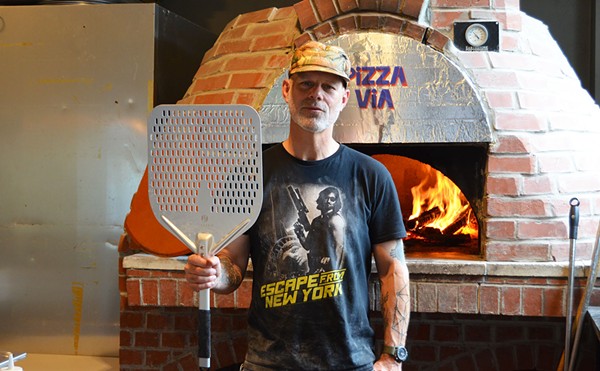On my first visit to this Honduran restaurant -- a ramshackle, homey hovel that opened in January along Cherokee Street's predominantly Mexican strip of eateries, groceries and tamale-making operations -- I'm not sure if I even gave the sour cream much thought.
There was too much other stuff to take in: the Spanish-language soaps blaring at high volume from a pink-tinted TV screen in the back corner; the engulfing language barrier between the kind, soft-spoken waitress (who admitted in a near-whisper that she didn't really speak English) and myself (what little Spanish I've got under my belt came from deciphering NYC subway ads, which basically means I know how to say, "Learn English"); and the colorful postcards placed under the clear vinyl tablecloths, trumpeting tropical destinations foreign to me both literally and figuratively, places like Puerto Cortes and La Ceiba.
Between my second and third meal at Los Catrachos, though, I was definitely onto that sour cream. And wondering what the deal was with it. Orders such as platano frito con mantequilla y crema (fried plantain with beans and sour cream) and baleada con frijoles, queso y crema (bean burrito with cheese and sour cream) came topped with a pale yellow, viscous sauce that certainly was not American sour cream, but certainly was good. Stranger still, its flavor seemed to amend itself just slightly from dish to dish. Once it bore a slight resemblance to hollandaise; another time it almost tasted like crème anglaise.
I started asking questions.
Alex, a congenial guy who's quickly become one of my favorite waiters in town, told me it was like a mixture of sour cream and mayonnaise. But the following week, I posed the same question to Los Catrachos' owner, Dennis Machado, who immigrated here from Honduras fifteen years ago. He described it as mayo with a little ketchup (Big Mac "special sauce" without the relish?). I tried whipping up both versions at home and wound up with a whole lotta nothing. I went back to Los Catrachos once more. This time the sour cream, doled out atop an irresistibly sweet corn tamalito that could have been corn pudding, really did convey the flavor of mayonnaise. But this time Alex said that the sour cream, or whatever it really is, comes out of a jar that Machado buys on his monthly trips to Miami, where he also picks up Honduran spices and bottled soda pop.
I still haven't gotten to the bottom of the sour cream mystery, and as far as I'm concerned, that's a happy dilemma to have. Then again, I don't need food-sleuthing as a reason to return to Los Catrachos (the name, by the way, is friendly slang for "Hondurans"). The food is great.
Along the isthmus of Central America, Guatemala and Belize separate Honduras from Mexico; it's bordered to the south by Nicaragua and El Salvador. Its cuisine falls in line with its geography, and while Los Catrachos' menu does include enchiladas, empanadas, tamales and burritos, it shares little in common with typical Mexican fare. Pupusas, corn masa patties stuffed with cheese, beef and/or vegetables, are considered the national provision of El Salvador, where they're often served up in pupuserias and, according to Machado, "are like hamburgers are in the U.S." They're a main course in El Salvador but a snack or appetizer to Hondurans. Like the sour cream, the pupusas at Los Catrachos kept playing tricks on me. One night they were filled with a gooey, melted, mozzarella-like cheese, their gordita-style shell fried to a thin, nifty crisp. On another night, savory ground beef awaited inside a thicker, softer masa, so that the whole thing came off more like an empanada. Either way, they were delicious, and I was very content to roll with the punches.
The starch root yucca (sometimes known stateside as cassava) is native to South America and is a staple of Honduran cooking. In its raw form, yucca bears a dark brown skin and can grow up to a foot in length and about two or three inches in diameter, making it look like a gnarled table leg. When cooked, its meat is almost translucent, with the flavor of a sugar-laced Idaho potato. On Los Catrachos' menu, yucca is featured most prominently in the entrée yucca con chicarrron -- yucca with pork rinds, a towering buffet-on-a-plate containing chunks of yucca, scoops of wild rice and (get this!) potato salad, a few pieces of plantain, refried beans and honest-to-goodness pork rinds.
All of that is topped with curtido, a native cole slaw. Honduras takes its cole slaw so seriously that there are two distinct kinds of it. One is shredded white cabbage and carrots pickled in white vinegar, and jars of it sit on each table at Los Catrachos, to be used as a condiment or eaten straight-up. A dry curtido is what rests atop the yucca con chicarron, this one tossed with white onions, cilantro, beets and beet-stained pieces of cucumber.
The curtido accompanies nearly everything at Los Catrachos -- the empanadas, the pupusas, a whole fried tilapia, chunks of fried pork chop. It turns every dish it touches into a happy mess of commingling flavors. And I'm not complaining.





